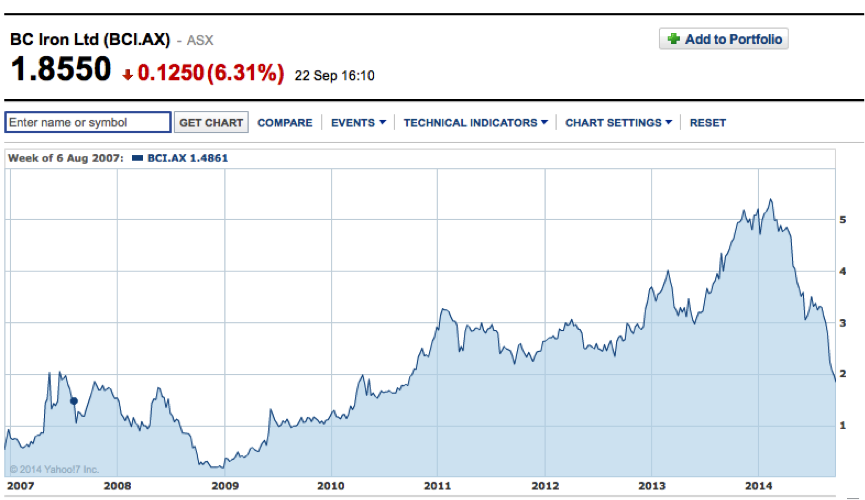
The Essential Ingredient; Humility.
Since 2010 here on the blog, we have been warning investors consistently about the dangers of ‘investing’ in iron ore. Let us explain.
The very best businesses to own –that sustainably reinvest large amounts of capital at very high rates of return – are those in which the most valuable competitive advantage inheres. That competitive advantage – the most valuable one – is the ability to raise prices in the face of excess supply.
Mining companies, by definition, cannot do this. They are price takers, and in the face of excess supply, the price for the commodity they produce falls and they must simply accept it. As prices for the commodity they produce continues to fall, those with the highest production costs, must shutter unprofitable mines, lest they themselves collapse. Many less experienced analysts of course hope that commodity price falls will be limited to the cost of production. These analysts must also believe in the tooth fairy, because there is no evidence in history that shows commodity price falls are limited to the production cost of their producers.
The impact of falling commodity prices on returns for shareholders can be seen in the illustrated example. Back in October 2012, the iron price was approximately USD$160/t and BCI was trading at $3.00, with investors enquiring as to the prospects for the company (see video link below). More recently, BCI’s shares traded as high as $5.41 despite a generally declining iron ore price (now circa USD$88/t). Since February however BCI shares have slumped and now trade at $1.85. We are concerned that some analysts might now be encouraging investors to buy on the basis that the ‘stock’ is cheap. As we all have no doubt learned from bitter and painful experience, a company isn’t cheap simply because it’s share price has fallen a lot. It is cheap only when the price is at a discount to a rational assessment of its value, which contains its future prospects. The great challenge, we have learned, is judging mining company prospects requires an accurate forecast about the price of the commodity. And even if we are prescient in our commodity forecast, there’s the issues of production costs, management skill, corporate governance, currency hedging, and even the weather.
This of course matters not to ‘loquacious’ pundits who, after tipping a stock and finding they were premature or simply wrong, move on to the next opportunity with a retort such as; “while in hindsight my timing was premature, I remain of the view it is a cheap stock”.
However, cheap stocks do not necessarily make great investments, nor are they necessarily great businesses – particularly if they harbour no competitive advantages.
It does strike us here at Montgomery that there are some very vocal brokers who frequently proffer their ‘wisdom’ on market matters, but on any superficial analysis are revealed to be little more than ‘punters’ or ‘tipsters’. They do not care for an understanding of the difference between speculating and investing, and sadly – with salaries that reflect their popularity rather than their accuracy – they believe completely in their own hubris; waving goodbye to disaffected fans with a smile.
As an aside, you might like to watch here, fast-forwarding to 4.40m. You might also like to watch up to the 17-minute mark, where there are a few very useful investing ‘lessons’…

Carlos
:
Roger, not many people at all use small cap mining stocks for long term investing. but using sensible medium term buying and selling, I have made spectacular returns with plenty of them. there is a place for it, but obviously not the majority of one’s portfolio.
Roger Montgomery
:
You must have a special gift Carlos. Well done.
Kelvin Ng
:
Hi Roger, there are production costs and then there are production costs – are we talking about highest quartile production costs, average production costs, or lowest quartile production costs etc.? Whether there is evidence in history showing commodity price falls being limited to production costs depends on what production costs we are talking about!
Kelvin
Roger Montgomery
:
Hi Kelvin,
For each company there’s only one.
Andrew Legget
:
This reminds me of something i realised a while ago in relation to investing. I then dubbed it “the pirate rule” as “there be pirates lurking around every cove, waiting to board”.
There is a lot of advice, both formal and informal, for particpants on the share market. However, there is always a large dose of self interest at play and investors need to be wary and vigilent and not just blindly accept the views of those that they feel may know better than they do. They may have a point but they may also have other things in mind.
Always test and research yourself any advice you get and take control of your own investments. There are always reasons why someone may give you advice which does not correlate necessarily to you making a profitable investment.
Roger Montgomery
:
Sounds advice Andrew. Thanks
Simon Stewart
:
Well from 2010 to 2014 you would have had a 400% return on your investment. Risk reward? As always when to sell is as important as when to buy. Some recent non mining examples which you would have thought low risk would be McMillian Shakespeare, The Reject Shop, Ainsworth Gaming all have taken substantial hits over the last year with the reasons not as obvious as commodity prices.
Roger Montgomery
:
Selling is indeed one of the most difficult decisions and there are many paths to a successful approach. Perhaps the most important contributor is applying the chosen approach consistently.
Tim Mann
:
Hi Roger,
Once again, you make a great point about the financial dangers of following these spruikers and ‘churn and burn’ merchants. May I encourage you and your peers to boycott these brokers, which do such a huge disservice to investors.
Keep up the good work,
Tim
Scott T
:
Great to listen to the old clip of YMYC from 2012. At the 11.35 mark a caller asks if Sirtex is over priced at $7.80. Ohh those were the days.
All the best
Scott T